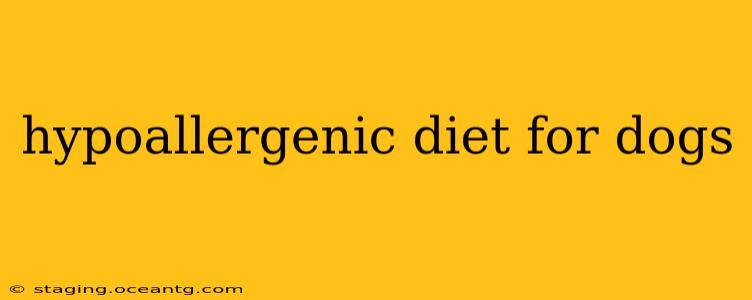Many dogs suffer from allergies, leading to itchy skin, digestive upset, and other uncomfortable symptoms. A hypoallergenic diet can be a game-changer for these dogs, significantly improving their quality of life. But navigating the world of hypoallergenic dog food can be confusing. This guide will delve into the intricacies of hypoallergenic diets, helping you understand what they are, how they work, and how to choose the best option for your furry friend.
What is a Hypoallergenic Dog Food?
A hypoallergenic dog food is designed to minimize or eliminate allergens that commonly trigger canine allergies. These allergens can include proteins (like beef, chicken, dairy, soy, and wheat) and certain carbohydrates. The goal is to provide complete and balanced nutrition while avoiding ingredients known to cause adverse reactions in sensitive dogs. Hypoallergenic diets aren't just about excluding common allergens; they also often incorporate novel protein sources and highly digestible ingredients to support optimal gut health.
What are the Different Types of Hypoallergenic Diets?
There are primarily two types of hypoallergenic diets:
1. Hydrolyzed Protein Diets: These diets break down proteins into smaller peptides or amino acids, making them less likely to trigger an allergic reaction. Because the proteins are essentially "deconstructed," the immune system doesn't recognize them as foreign invaders. These diets are often recommended for dogs with severe allergies.
2. Novel Protein Diets: These diets utilize protein sources that are uncommon in a dog's typical diet. Examples include venison, kangaroo, rabbit, duck, or fish like salmon or cod. The idea is that because the dog hasn't been previously exposed to these proteins, there's a lower chance of an allergic reaction. These diets are often a good starting point for dogs with milder allergies.
How Do I Know if My Dog Needs a Hypoallergenic Diet?
Several signs indicate your dog might benefit from a hypoallergenic diet. These include:
- Itchy skin: Chronic scratching, licking, and chewing.
- Skin infections: Hotspots, recurring ear infections, or skin rashes.
- Digestive issues: Vomiting, diarrhea, gas, or changes in bowel movements.
- Paw licking and chewing: Often a sign of food allergies.
- Sneezing and coughing: While not always indicative of food allergies, these symptoms can sometimes be linked.
If you suspect your dog has allergies, it's crucial to consult your veterinarian. They can perform allergy testing or recommend an elimination diet to identify the specific allergen(s).
What are the common ingredients in hypoallergenic dog food?
Hypoallergenic dog foods typically use novel protein sources like venison, duck, kangaroo, or fish (salmon, cod). They also often include highly digestible carbohydrates like sweet potatoes or brown rice to avoid triggering sensitivities. Hydrolyzed protein diets use highly processed proteins broken down into smaller peptides, making them less allergenic. Ingredients are carefully selected to minimize potential triggers.
How long does it take to see results from a hypoallergenic diet?
The time it takes to see improvements varies from dog to dog. Some dogs may show improvements within a few weeks, while others might take a couple of months. Consistent feeding of the hypoallergenic diet is key. Be patient and work closely with your vet to monitor your dog's progress.
Can I make my own hypoallergenic dog food?
While you can attempt to make a hypoallergenic diet at home, it's crucial to ensure it's completely balanced nutritionally to avoid nutritional deficiencies. Consult with a veterinary nutritionist before attempting this, as mistakes can have serious consequences for your dog's health. Commercially available hypoallergenic diets are formulated by experts to provide complete and balanced nutrition.
What are the potential side effects of a hypoallergenic diet?
While generally safe and effective, some dogs may experience temporary digestive upset, such as mild diarrhea or gas, when transitioning to a new diet. These side effects usually subside as the dog adjusts. If your dog experiences significant or persistent side effects, contact your veterinarian.
Choosing the Right Hypoallergenic Diet for Your Dog
Selecting the appropriate hypoallergenic diet requires careful consideration. Work closely with your veterinarian to determine:
- The severity of your dog's allergies: Mild allergies may respond to novel protein diets, while severe allergies might necessitate hydrolyzed protein diets.
- Your dog's individual needs and preferences: Some dogs are more picky eaters than others.
- Your budget: Hypoallergenic diets can be more expensive than regular dog food.
By understanding the different types of hypoallergenic diets and working closely with your veterinarian, you can help your allergic dog live a happier, healthier life, free from the discomfort of allergic reactions. Remember, patience and consistent monitoring are key to success.
